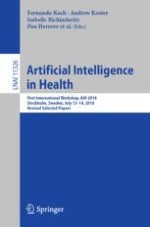2019 | Book
Artificial Intelligence in Health
First International Workshop, AIH 2018, Stockholm, Sweden, July 13-14, 2018, Revised Selected Papers
Editors: Fernando Koch, Dr. Andrew Koster, David Riaño, Dr. Sara Montagna, Prof. Michael Schumacher, Annette ten Teije, Christian Guttmann, Manfred Reichert, Prof. Isabelle Bichindaritz, Ph.D. Pau Herrero, Richard Lenz, Prof. Beatriz López, Prof. Cindy Marling, Dr. Clare Martin, Prof. Stefania Montani, Nirmalie Wiratunga
Publisher: Springer International Publishing
Book Series : Lecture Notes in Computer Science
